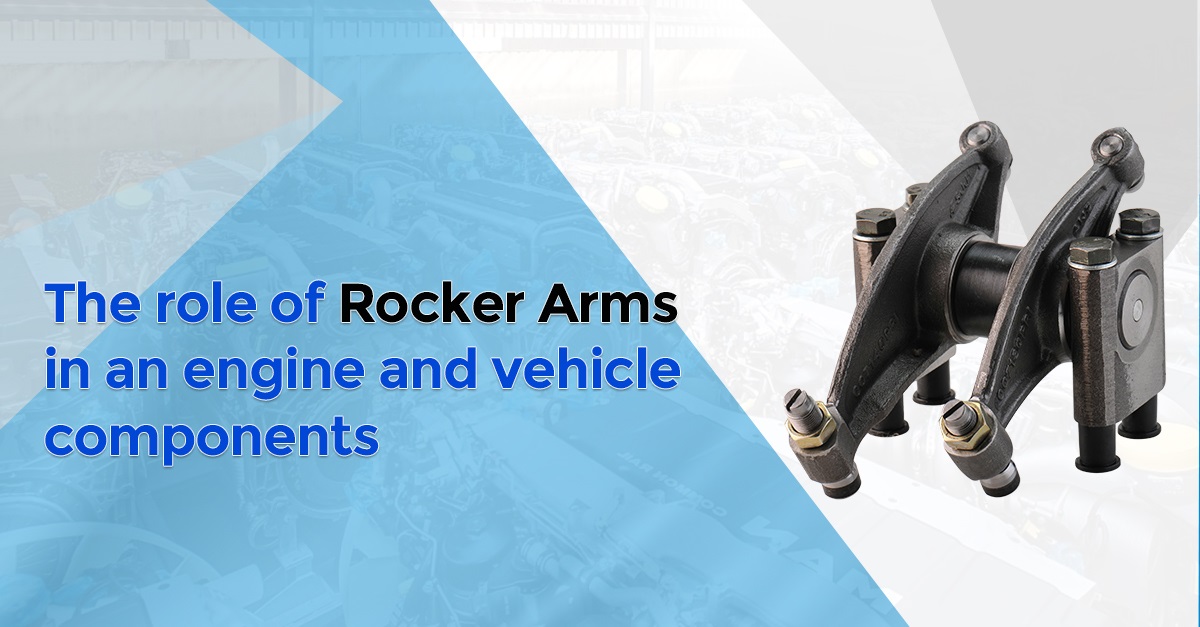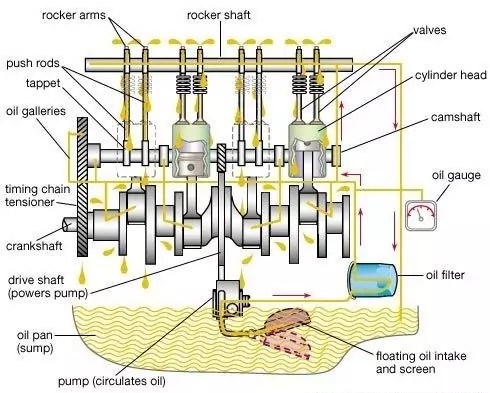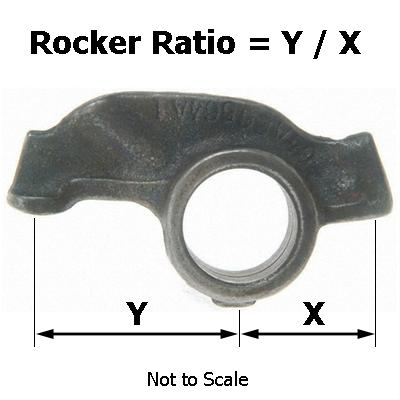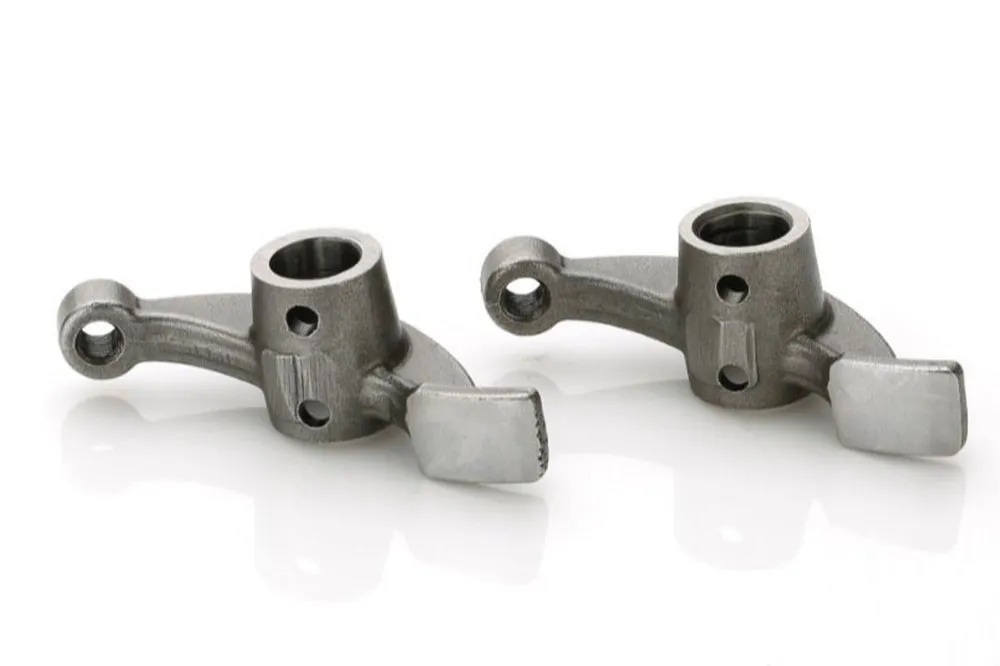

In an internal combustion (IC) engine, the rocker arm is a mechanical device that transmits the motion of the pushrod to its corresponding exhaust and intake valves. A rocker arm is situated between the exhaust and intake valves as well as a pushrod. It works as an intermediary between the camshaft and the valves.
The rocker is connected to the camshaft by the pushrod. Camshaft sets pushrod into motion that pushes the rocker arms. The rocker arm opens and closes the inlet and exhaust valve as it is actuated by the pushrod. In other words, the camshaft cam pushes up on the rocker arm (via a pushrod), which in turn pushes down on the valves.
The materials employed in the rocker arm construction are Alloy steels, aluminum or stamped steel. There are major types of rocker arms such as stamped steel rocker arms, shaft rocker arms, full roller rocker arms, and roller-tipped rocker arms. Certain types of rocker arms come up with a type of bearing at the contact point in order to decrease friction along with wear and tear or rusting. It is also important to note that types of rocker arms also depend upon which type of internal combustion (IC) engine is used in a vehicle (i.e. pushrod engine, overhead cam engines, etc.).

A rocker arm is a part of the engine that ensures proper fuel supply to it. The adequate supply of fuel to the engine is ensured due to the proper functioning of the rocker. The rocker arm's primary function is transferring the camshaft's motion to the inlet and exhaust valves while ensuring adequate opening and closing. The efficient working of a vehicle is dependent upon the efficient working of the rocker arm.
The horsepower is freed by rocker arms and they lessen the level of friction in the valve train. As per the specifications recommended by the international engineering standards with regard to vehicle components, rocker arms are developed from materials such as alloy steels of top-notch quality that help ensure the strength and durability of the engine.
The engine rocker arm is a mechanical distribution component on the valve assembly in the internal combustion engine. As the name suggests, the roller rocker arms come with new roller technology that when applied to an engine results in a synchronous transmission between the camshaft, hydraulic tappets, and valves by employing the rolling effect between the cam and the rocker arms. This leads to the loss of friction, less heat, and better lubrication efficiency that directly impacts the performance for the better and ensures the durability of rocker arm components.

As mentioned earlier, a rocker arm is a mechanically advantaged lever that translates camshaft data into valve actuation. The mechanical advantage is defined by a rocker’s ratio. The rocker arm ratio determines the effective leverage of the arm. The ideal leverage ratio of a rocker arm is considered to be somewhere between 1.5:1 to 1.8:1. A lot more power can be attained by equalizing all rocker arms to a consistent 1.5:1 ratio. You can build even more power by optimizing rocker ratios to change the opening and closing events of the cam.
Rocker arms are also prone to faults and damage. Any faults or damage in the rocker arm causes the power of the engine to reduce or lead to its complete failure. However, there are ways to ways to detect a faulty or damaged rocker arm by examining its symptoms. These include clicking or ticking noise, weak engine performance, engine lights turned on, and physical deterioration. If the rocker arm appears to work well under visual inspection, some troubleshooting from your end or by a local mechanic is good enough to solve the problem.
Generally speaking for economy cars, rocker arms are made up of stamped steel. Steel, being strong and lightweight, is a good option for economy cars. High-performance vehicles use aluminum rocker arms because they are lightweight. Conversely, truck engines require stronger rocker arms made out of carbon steel or cast iron.

The rocker arm is a fundamental component of the valve actuating mechanism of an internal combustion engine. Over the years, rocker arms have been optimized in their design and material for better performance. Durability, toughness, high dimension stability, wear resistance, strength, and cost of materials as well as economic factors are also the reasons for optimization of rocker arm.
Rocker arm is an important component of an engine and its failure renders an engine useless and also requires costly procurement and replacement. Lightweight rocker arms are a plus for high rpm applications but the strength of rocker arm is also essential to prevent failure. Some steel rockers are almost as light as aluminum rockers. But steel has better fatigue strength and stiffness than aluminum. Steel is better material in terms of strength and aluminum is good for making low-cost rocker arms.
Ghaziabad Precision Products (GPP) is a world-class valve train manufacturing company that offers smart technology and comprehensive solutions for valve train components, casting products, chassis components, and engineering springs. GPP is equipped with the latest advanced machinery and auto equipment in hot forging, projection welding, spring end grinding, precision machining, hardening & tempering, shot peening, and so much more. It believes in delivering the best quality at the lowest competitive cost and strives for excellence while delighting its customers in whatever it does.
Post a comment